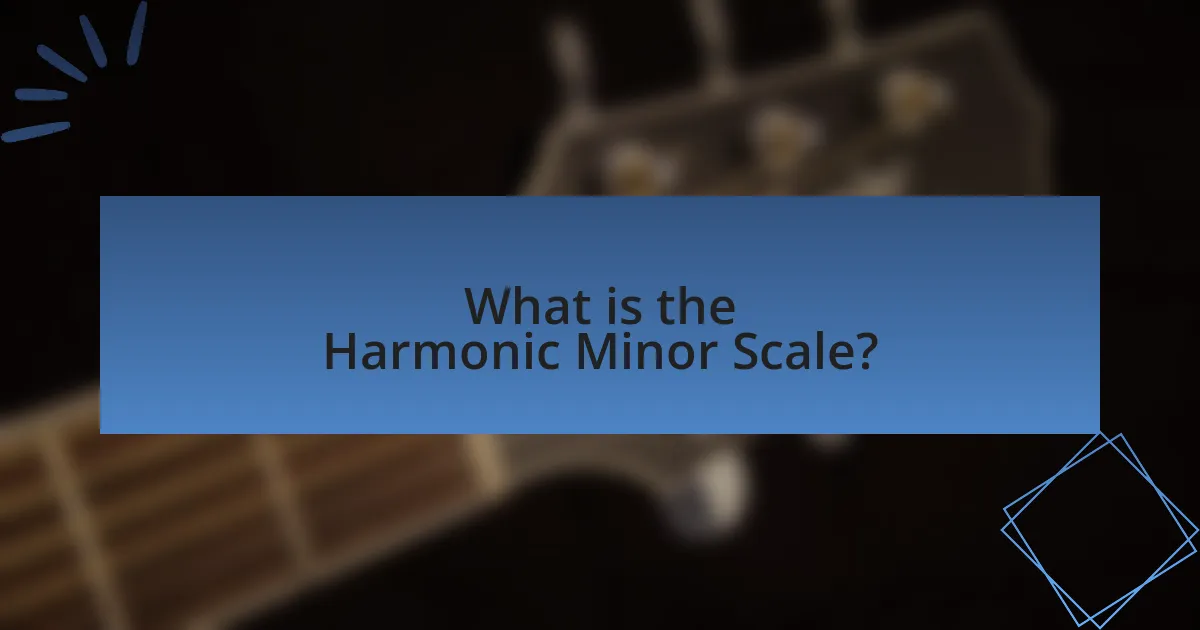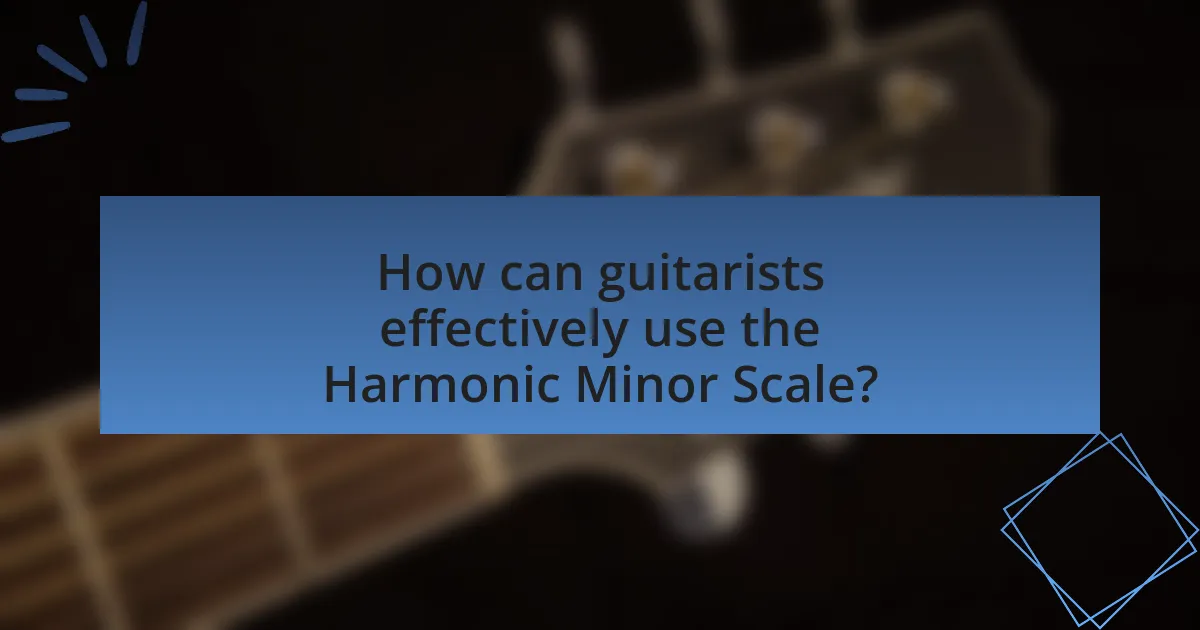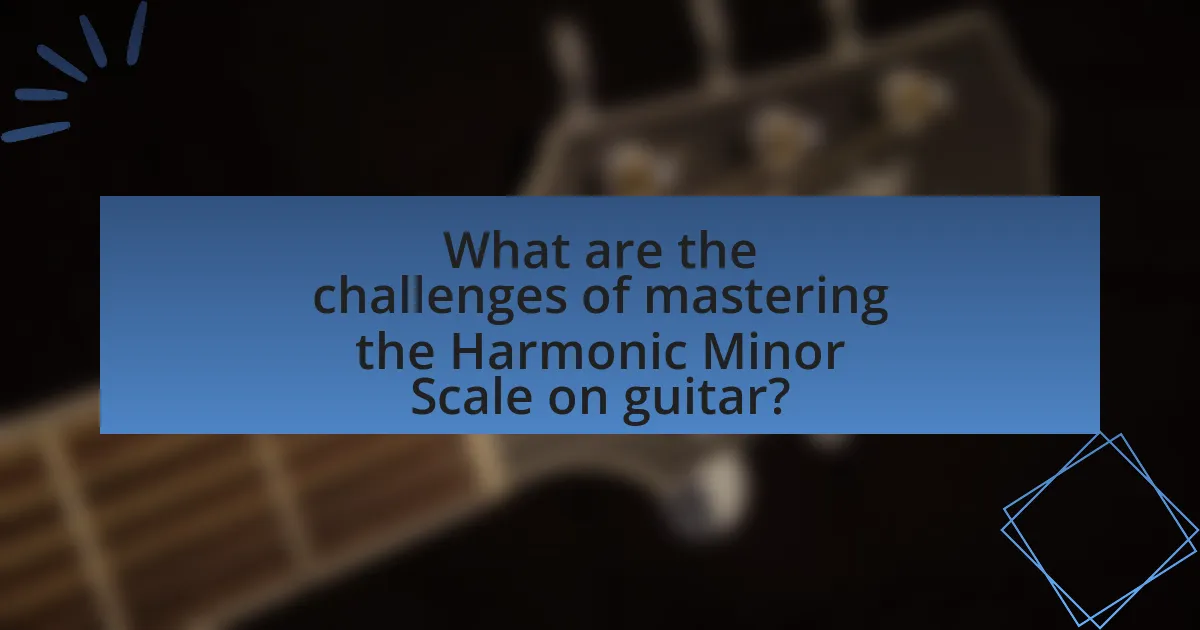The Harmonic Minor Scale is a seven-note scale derived from the natural minor scale, characterized by a raised seventh degree that creates a leading tone, enhancing harmonic tension and resolution. This article explores the construction, significance, and application of the Harmonic Minor Scale for guitarists, detailing its unique intervals, common patterns, and techniques for effective use in improvisation and composition. Additionally, it addresses challenges in mastering the scale, common mistakes, and resources available for learning, making it a comprehensive guide for musicians looking to expand their musical vocabulary and expression.

What is the Harmonic Minor Scale?
The Harmonic Minor Scale is a seven-note scale that is derived from the natural minor scale by raising the seventh note. This alteration creates a distinctive sound characterized by a leading tone that resolves to the tonic, which is particularly useful in classical and jazz music. The scale is structured as follows: whole step, half step, whole step, whole step, half step, augmented second, half step. For example, in the A harmonic minor scale, the notes are A, B, C, D, E, F, and G#. This raised seventh (G#) provides a unique tension that is often utilized in guitar solos and compositions to create a dramatic effect.
How is the Harmonic Minor Scale constructed?
The Harmonic Minor Scale is constructed by altering the seventh degree of the natural minor scale, raising it by a half step. This results in the following sequence of whole and half steps: whole, half, whole, whole, half, augmented second, half. For example, in the A Harmonic Minor Scale, the notes are A, B, C, D, E, F, and G#. The inclusion of the raised seventh (G#) creates a leading tone that enhances the scale’s harmonic function, particularly in Western music, where it is often used to create tension and resolution in chord progressions.
What notes make up the Harmonic Minor Scale?
The Harmonic Minor Scale consists of the following notes: the root, major second, minor third, perfect fourth, perfect fifth, minor sixth, and major seventh. Specifically, in the key of A, the notes are A, B, C, D, E, F, and G#. This scale is characterized by the raised seventh degree, which creates a distinctive sound often used in various musical genres, particularly in classical and Middle Eastern music. The inclusion of the major seventh (G# in A Harmonic Minor) differentiates it from the natural minor scale, reinforcing its unique harmonic qualities.
How does the Harmonic Minor Scale differ from the Natural Minor Scale?
The Harmonic Minor Scale differs from the Natural Minor Scale primarily in its seventh degree, which is raised by a half step in the Harmonic Minor. This alteration creates a leading tone that resolves to the tonic, enhancing harmonic tension and resolution. For example, in the A Natural Minor Scale, the notes are A, B, C, D, E, F, and G, while in the A Harmonic Minor Scale, the notes are A, B, C, D, E, F, and G#. This raised seventh degree is crucial for creating dominant chords and establishing a stronger sense of tonality, which is often utilized in various musical genres, particularly in classical and Middle Eastern music.
Why is the Harmonic Minor Scale important for guitarists?
The Harmonic Minor Scale is important for guitarists because it provides a unique sound that enhances musical expression, particularly in genres like classical, jazz, and metal. This scale introduces a raised seventh degree, which creates a leading tone that resolves to the tonic, adding tension and drama to melodies and harmonies. Guitarists utilize the Harmonic Minor Scale to create distinctive solos and improvisations, allowing for the incorporation of exotic and emotional elements into their playing. Its application in various musical contexts, such as the use of diminished chords and altered dominant chords, further solidifies its significance in expanding a guitarist’s musical vocabulary.
What musical genres commonly utilize the Harmonic Minor Scale?
The Harmonic Minor Scale is commonly utilized in genres such as classical, jazz, metal, and flamenco music. In classical music, composers like Bach and Mozart have employed this scale to create tension and resolve in their compositions. Jazz musicians often use the Harmonic Minor Scale for improvisation, particularly in minor key contexts, allowing for rich harmonic possibilities. Metal genres, especially neoclassical metal, frequently incorporate the scale for its dramatic and exotic sound, while flamenco music uses it to evoke traditional Spanish melodies. These genres leverage the unique intervals of the Harmonic Minor Scale to enhance their musical expression.
How does the Harmonic Minor Scale enhance improvisation on guitar?
The Harmonic Minor Scale enhances improvisation on guitar by providing unique melodic and harmonic options that create tension and resolution. This scale features a raised seventh degree, which introduces a leading tone that resolves to the tonic, allowing guitarists to craft more expressive solos. The distinct intervals of the Harmonic Minor Scale, particularly the augmented second between the sixth and seventh degrees, contribute to a Middle Eastern or exotic sound, enriching the improvisational palette. Additionally, its application in various genres, such as jazz and classical, demonstrates its versatility and effectiveness in creating dynamic musical phrases.

How can guitarists effectively use the Harmonic Minor Scale?
Guitarists can effectively use the Harmonic Minor Scale to create tension and resolve in their solos, particularly in genres like classical, metal, and jazz. This scale features a raised seventh degree, which introduces a leading tone that enhances the harmonic movement towards the tonic. By incorporating the Harmonic Minor Scale into improvisation, guitarists can emphasize its unique intervals, such as the augmented second between the sixth and seventh degrees, to evoke a distinct emotional quality. Additionally, using this scale over dominant chords allows for the creation of strong resolutions, making it a powerful tool for enhancing musical expression.
What are some common patterns for playing the Harmonic Minor Scale on guitar?
Common patterns for playing the Harmonic Minor Scale on guitar include the three-note-per-string pattern, the two-octave scale pattern, and the pentatonic variation. The three-note-per-string pattern allows for fluid movement across the fretboard, facilitating quick transitions between notes. The two-octave scale pattern provides a comprehensive coverage of the scale, making it easier to incorporate into solos. The pentatonic variation simplifies the scale into a five-note format, which is often used in improvisation. These patterns are widely recognized among guitarists for their effectiveness in navigating the unique intervals of the Harmonic Minor Scale, particularly the augmented second between the sixth and seventh degrees, which characterizes its sound.
How can guitarists practice these patterns effectively?
Guitarists can practice harmonic minor scale patterns effectively by using a structured approach that includes slow practice, metronome use, and focused repetition. Slow practice allows guitarists to ensure accuracy in finger placement and technique, which is crucial for mastering complex patterns. Utilizing a metronome helps maintain a consistent tempo, gradually increasing speed as proficiency improves. Focused repetition of specific patterns reinforces muscle memory and enhances familiarity with the scale. Research indicates that deliberate practice, characterized by these methods, significantly improves skill acquisition in musicians (Ericsson et al., 1993).
What fingerings are recommended for the Harmonic Minor Scale?
The recommended fingerings for the Harmonic Minor Scale on guitar typically involve using the following patterns: for the A Harmonic Minor Scale, start on the 5th fret of the low E string with your index finger, then use your ring finger on the 7th fret, followed by your pinky on the 8th fret on the A string. Continue this pattern up to the high E string, using your index finger on the 5th fret, middle finger on the 6th fret, and ring finger on the 7th fret. This fingering allows for smooth transitions and efficient movement across the strings. The use of these specific finger placements is widely taught in guitar pedagogy, ensuring that players can effectively navigate the scale while maintaining proper technique.
How can the Harmonic Minor Scale be applied in solos?
The Harmonic Minor Scale can be applied in solos to create tension and resolve effectively, particularly in genres like classical, jazz, and metal. This scale features a raised seventh degree, which introduces a leading tone that enhances the harmonic movement towards the tonic, making it ideal for improvisation over dominant chords. For example, when soloing over a V7 chord, the use of the Harmonic Minor Scale allows musicians to incorporate the leading tone, creating a strong pull back to the I chord. Additionally, the unique intervals of the scale, especially the augmented second between the sixth and seventh degrees, provide distinctive melodic options that can evoke emotional depth in solos.
What techniques can be used to incorporate the Harmonic Minor Scale into solos?
To incorporate the Harmonic Minor Scale into solos, musicians can utilize techniques such as arpeggiation, chromatic passing tones, and modal interchange. Arpeggiation allows players to outline the chords derived from the scale, emphasizing the unique intervals, particularly the augmented second between the sixth and seventh degrees. Chromatic passing tones can create tension and resolution, enhancing melodic lines by connecting scale degrees smoothly. Modal interchange involves borrowing chords from related modes, such as the Dorian or Phrygian, to add harmonic variety while maintaining the essence of the Harmonic Minor Scale. These techniques effectively highlight the scale’s distinct sound and contribute to more expressive solos.
How can phrasing be improved when using the Harmonic Minor Scale in solos?
Phrasing can be improved when using the Harmonic Minor Scale in solos by incorporating techniques such as varying note lengths, using rests strategically, and emphasizing strong beats. These techniques create a more dynamic and expressive musical line. For instance, varying note lengths can help to create tension and release, while strategic rests allow for breathability in the solo, making it more engaging. Emphasizing strong beats aligns with the rhythmic structure of the music, enhancing the overall impact of the solo. These methods are supported by the fact that skilled improvisers often utilize these techniques to create memorable and compelling solos, as seen in the works of renowned guitarists who frequently employ the Harmonic Minor Scale.

What are the challenges of mastering the Harmonic Minor Scale on guitar?
Mastering the Harmonic Minor Scale on guitar presents several challenges, primarily due to its unique interval structure and the need for precise finger positioning. The scale features a raised seventh degree, which creates a distinctive sound but also requires guitarists to adjust their playing techniques to accommodate this interval. Additionally, the scale’s application in various musical contexts, such as classical, jazz, and metal, demands versatility and adaptability in improvisation and composition.
Furthermore, the fingerings can be complex, especially when transitioning between different positions on the neck, which can hinder fluidity and speed. Practicing the scale in various keys and integrating it into different musical styles can also be daunting, as it necessitates a deep understanding of music theory and ear training to effectively utilize the scale in performance.
What common mistakes do guitarists make when learning the Harmonic Minor Scale?
Guitarists commonly make mistakes such as neglecting the unique intervals of the Harmonic Minor Scale, particularly the augmented second between the sixth and seventh degrees. This oversight can lead to incorrect finger positioning and diminished melodic expression. Additionally, many guitarists fail to practice the scale in various positions across the fretboard, which limits their ability to utilize the scale effectively in different musical contexts. Another frequent error is not incorporating the scale into improvisation or composition, resulting in a lack of practical application and understanding of its sound. These mistakes hinder a guitarist’s overall mastery of the Harmonic Minor Scale and its expressive potential in music.
How can these mistakes be avoided?
To avoid mistakes when exploring the harmonic minor scale on guitar, musicians should practice regularly with a metronome to develop timing and precision. Consistent practice helps reinforce muscle memory and ensures that notes are played accurately. Additionally, focusing on proper finger positioning and technique can prevent common errors such as incorrect note execution. Research indicates that deliberate practice, which includes slow and methodical playing, significantly enhances skill acquisition in musicians (Ericsson et al., 1993). By implementing these strategies, guitarists can effectively minimize mistakes while mastering the harmonic minor scale.
What strategies can help overcome difficulties with the Harmonic Minor Scale?
To overcome difficulties with the Harmonic Minor Scale, practicing the scale in various positions on the guitar is essential. This approach allows musicians to familiarize themselves with the unique intervals and fingerings associated with the scale. Additionally, incorporating the scale into improvisation exercises can enhance fluency and comfort, as it encourages the application of the scale in musical contexts. Furthermore, using backing tracks in the harmonic minor key can provide a practical framework for applying the scale, reinforcing its sound and structure. Regularly analyzing pieces of music that utilize the Harmonic Minor Scale can also deepen understanding and inspire creative use of the scale in performance.
What resources are available for learning the Harmonic Minor Scale?
Resources available for learning the Harmonic Minor Scale include instructional books, online courses, video tutorials, and mobile applications. Notable books such as “The Complete Guitarist” by Richard Chapman provide structured lessons on scales, including the Harmonic Minor. Online platforms like Udemy and Coursera offer courses specifically focused on guitar scales, while YouTube channels like JustinGuitar and GuitarLessons.com feature free video tutorials that demonstrate the scale’s application. Additionally, apps like Yousician and GuitarTuna provide interactive learning experiences that include exercises for practicing the Harmonic Minor Scale.
Which online platforms offer lessons on the Harmonic Minor Scale?
Online platforms that offer lessons on the Harmonic Minor Scale include YouTube, Guitar Tricks, and JamPlay. YouTube features numerous instructional videos from various guitar educators, providing free access to lessons on the Harmonic Minor Scale. Guitar Tricks offers a structured curriculum with specific lessons dedicated to this scale, allowing users to learn at their own pace. JamPlay also provides comprehensive courses that cover the Harmonic Minor Scale as part of their guitar education programs.
What books are recommended for mastering the Harmonic Minor Scale on guitar?
“Melodic Minor Guitar” by David Oakes is highly recommended for mastering the Harmonic Minor Scale on guitar. This book provides comprehensive exercises and insights specifically focused on the harmonic minor scale, making it an essential resource for guitarists. Additionally, “The Complete Guitarist” by Richard Chapman includes sections that cover various scales, including the harmonic minor, with practical applications and exercises. These books are recognized for their structured approach and effectiveness in teaching the harmonic minor scale to guitar players.
What are some practical tips for using the Harmonic Minor Scale in compositions?
To effectively use the Harmonic Minor Scale in compositions, incorporate its distinctive interval structure, particularly the raised seventh degree, to create tension and resolution. This scale’s unique sound can be utilized to evoke emotions, especially in genres like classical, jazz, and metal. For instance, when composing, emphasize the leading tone to the tonic, which enhances the sense of movement and anticipation. Additionally, experiment with modal interchange by blending the Harmonic Minor with other scales, such as the natural minor or major scales, to enrich harmonic progressions. This approach allows for diverse chord voicings and melodic lines, making compositions more dynamic and engaging.


